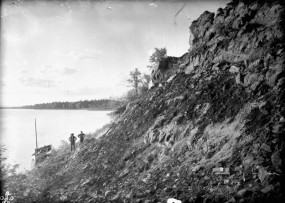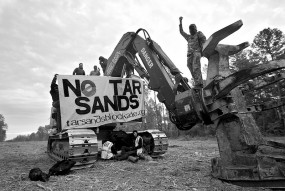
Tar Sands Geological Survey, Athabasca River, Alberta, 1892. D.B. Dowling, Geological Survey of Canada / Library and Archives Canada / PA-038166
The title of the poem signals the particular connection between Treaty 8 and settlement and resource extraction. Treaty 8 covers much of northern Alberta and parts of northeastern British Columbia, Saskatchewan, and the Northwest Territories. As Dennis F. K. Madill reports,
The overriding factor of the government’s decision to negotiate Treaty Eight involved economic considerations, not humanitarian or ideological concern for the Indians of the Peace River-Athabaska region. (71)
Bands from the Nîhithaw (Cree), Dene, Dene-zaa, and other First Nations signed the treaty during its implementation between 1899 and 1914.
As Rhodes notes, the region Treaty 8 covers is now the site of Canada’s tar sands strip mines. Rhodes points out in his footnote that he sculpted language from the treaty to resemble the form of the hydrocarbon compound coronene, associated with the tar sands. Rhodes’ rearrangement of Treaty 8 defamiliarizes the document to call attention to alternate understandings of the original text in relation to the motivations of its creators and its ongoing relevance to resource extraction.

Tar Sands blockade on November 18, 2012. Elizabeth Brossa, CC flickr, some rights reserved.
Many of the words in the poem repeat or mirror off each other, highlighting aspects of the treaties, such as promises of education. Similarly, the language is often broken or bent to meet the needs of oil extraction. Perhaps this transformation of treaty language suggests that treaties can be twisted to the interests of resource extraction, no matter the promises made. Or perhaps the poem is suggesting the treaty was always constructed to meet the changing needs of resource development rather than to support settler and Indigenous communities equally. By linking the treaty document to the tar sands in this way, Rhodes suggests a governmental legacy of privileging resources over humanitarian concerns.
Settlement, Mining, Lumbering, Trading: mediatation on Treaty Eight
by Shane Rhodes
.png)
Questions
- Words: Carefully examine the words and their arrangement. Which words are legible, and which are obscured? Which terms are highlighted, and why?
- Broken Words: How are words cut up and recombined to construct hints of others? What do the whole and broken words suggest about the content of the treaty?
- Chemical Structuring: The poem’s design is meant to link directly to an image of hydrocarbons associated with oil extraction. What is the significance of mirroring them at points, and the weaving or cycling at others? How does this change the treaty’s meaning?
- Cyclical Poetic Connections: How might “Settlement, Mining, Lumbering, Trading” extend the imagery and concepts of “Circle the Wagons”?








 ©
©